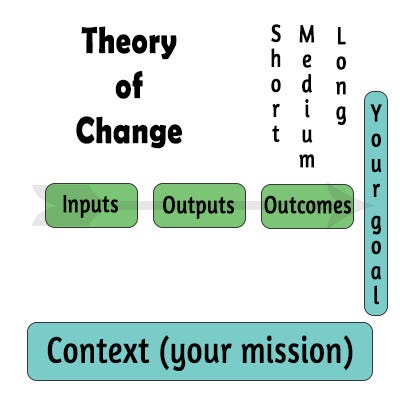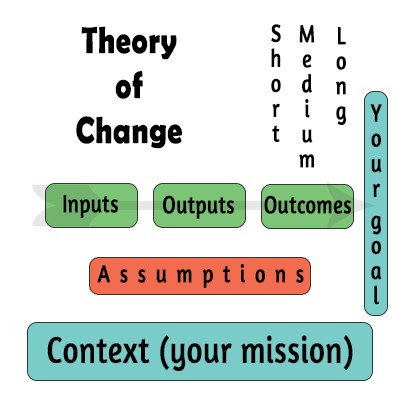If you work for any organisation aiming to have a positive impact, then you might have already have a theory of change.
Your theory of change should show how what you do, has a far reaching impact. Furthermore, it should also show that your impact is for the long-term, not just a one-off effort.
It’s a strategic piece of work that sets down the foundations for your business. It also tests your assumptions and ensures you have indicators to show the world how great you are. So let’s delve a little deeper into what’s involved.
When you started your organisation or project, you would have seen a problem you were hoping to solve. In addition, this provides your context that your theory of change relates to.
On top of this, you would have most likely stated your mission and vision. Ultimately the goals you, as an individual or group of individuals, are hoping to solve. Think of those goals again and translate them into something that we could think about measuring.
Goals / Context
For example, we need to focus our all reaching and broad ‘Improve the lives of those affected by addiction’. We could look more specifically at ‘Decrease deaths linked to overdose’ or ‘Improve the physical and psychological wellbeing of drug and alcohol users’. Or something like ‘Improve the physical and psychological wellbeing of carers of drug and alcohol users’.

Now we know where we’re heading, we can make a start. Firstly, jotdown what activities we carry out to reach our goals. These are known as our inputs.
Inputs
In this example, they could be things such as:
- provide education about drug and alcohol at schools
- run weekly meetings for addicts
- provide volunteer or job opportunities at the social enterprise.

These inputs lead directly to an output, and they will sound very similar.
Outputs
For each educational course in a school, 30 students will receive 4 hours of information about drugs and alcohol.
For every weekly meeting, 15 individuals with an addiction will attend.
Of the volunteer/job opportunities, 3 individuals will take up this offer.

So far, so good?
In fact, many funds these days will only ask you to report this back to them with similar information. However they have become very output driven, without really thinking about the different impact of what they are funding. We know it’s not just numbers that matter, but also what you’re offering and its quality.
This is why we now think about the outcomes. Some of which are easy to measure and some of which are challenging to. Furthermore, at this stage we need to think short, medium and long term in relation to what you’re doing. If you run a business, perhaps your long term could be from 10 years to a whole generation. If, on the other hand, you’re just looking at a year long pilot, then your long term could be between 3 and 5 years.
That’s entirely up to you. Now to focus on the outcomes for those taking up our volunteer/job opportunities. As this could be more relevant to those reading.
Outcomes
Short term — better and more structured routine, less likely to commit minor offences, unlikely to drink/use during the working day
Medium term — improved social skills, improved self-confidence, work ready, open to coming off unemployment benefits
Long term — employed elsewhere, stronger personal relationships outside of old circle, no offending

You can now see that we have completed the bulk of our theory of change. We have looked at what we are going to do, how we are going to do it, and the effect over time we hope it to have on its users. However, one thing still remains, and that is our assumptions.
In everything we do, we assume that people will react a certain way, we predict that doing x will lead to y, and that we will achieve our goals. Similarly, in both the business world and social sector, this doesn’t always happen, which is why we need to analyse our assumptions to make sure we don’t trip up.
We can look at our assumptions between each stage, and when we ask ourselves these questions, we can then strengthen what we are offering.
Have you ever heard of the NGO that gave out laptops to a village in Sub Saharan Africa, only to later find they were being used as paperweights? They’d made a lot of wrong assumptions — that the locals needed laptops, knew how to use them and had the power to run them, and ultimately didn’t reach their goal. Let’s not make the same mistake!
Theory of Change Assumptions
Inputs to Outputs
- Your users want to volunteer/work
- They want that sort of volunteer role/job position
- They will turn up as agreed to volunteer/work
Outputs to Outcomes
- Your users at a stage in recovery where reduction of using is possible
- They stick to the schedule given
- They will be physically/psychologically able to volunteer/work full time
Outcomes to Goal
- Job secured leads to improve physical and psychological wellbeing
- Job secured doesn’t lead to a return to old habits

In this example, I have limited the assumptions for each stage, however it is important to list as many as possible and answer them prior to starting your project or organisation. In short, the ones that are easier to answer can be removed when you feel you have adequately answered or countered it.
Engage your stakeholders in your theory of change
Putting together your theory of change should always be done with a wide range of stakeholders, to help combat these assumptions and really define what will work.
When I was part of setting up the social enterprise we used service user involvement to define how it would work that would make it more attractive to potential volunteers and employees. For example, we involved them in the visual identity, branding, product list, product selection, setting of hours, role allocation and so much more.
They felt ownership from the beginning, which ensured many of our assumptions were solved. We offered flexible shifts, a relaxed work ethic, smart uniforms, suitable perks and everyone was trained to be a barista. Consequently, they grew with confidence, made new friends and solved old problems. In addition, they broke their own prejudices as well as fought stigma against addiction.
One only lasted a few months, he shared his views that it wasn’t right for him, not hands on enough and he didn’t want to be in that location. As a result, some moved on to other jobs, and one or two still work their part time today.
The theory of change helped us take an idea, and turn it into reality to meet our goals. It’s not a complex thing to do, it doesn’t take weeks to do, and will really help you connect to your cause.
Give it a go and feel free to share what you’ve done or let us know if you’d like some help putting it together.

